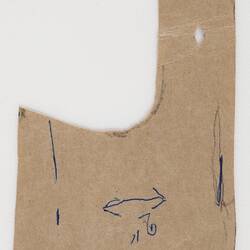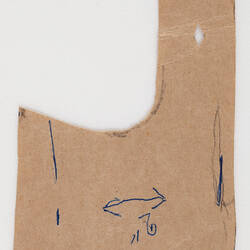Summary
This brown coloured stout 'L' shaped paper pattern with its diamond cutout and pen inscribed '2' referencing pattern depth, was most likely used by Stanio Fancoff as part of his shoe patterning schemata sometime between the 1930s - 1970s. Along with many others, this pattern was an integral part of Stanio's shoemaking craft and business.
Stanio Ivanoff Fancoff was born in 1908 in Bojentsi, a small village in Bulgaria. At age 11, Stanio left home to learn the shoemaking trade. In 1929, he immigrated to Melbourne, settled in Fitzroy and began to work for the V.G. Zemancheff & Sons basket shoe factory in South Melbourne. In1936, he married Dorotea Georgi Touzou who had recently arrived in Australia. Around this time, Stanio set up his own shoemaking business from home, with Georgi, her cousin and sister weaving the shoes which he then assembled. Select shoe samples were then taken to Sydney and Tasmania for sale. In 1942, Georgi and Stanio moved to Broken Hill for Georgi's health; there daughter Nancy was born and Stanio set up a shoe shop/factory. In 1945, Georgi died and by 1950 Stanio and Nancy had moved to Adelaide where he again opened a shoemaking business and shop. He passed away in 1978, having been in the shoemaking business for 59 years. This collection documents his migration and working life experiences.
Physical Description
Brown coloured paper 'L' shaped pattern. While the left edge exhibits traces of the original pen-cut line, the right edge's curvature has a mimicking pencil line. A dash pen line sits inset at approximately1cm from the top edge and the bottom edge illustrates several random scribble lines. Centrally located within the lower right region is diamond shaped cutout, while in the main right region a vertical positioned doubled headed arrow is drawn next to text. Although in good shape, the paper exhibits various crease marks.
Significance
This collection is significant in documenting a small migrant business as well as the fashion of a particular period. It is well provenanced and charts the application of trade skills in a new country. It also illustrates the stages of hand shoe manufacture from the 1930s, demonstrating the enduring nature of the tools and patterns that were used.
More Information
-
Collecting Areas
-
Acquisition Information
Donation from Nancy Vasileff, 21 Mar 2007
-
Maker
-
Inscriptions
Front, Handwritten, Blue Ink, Text: 2"
-
Classification
-
Category
-
Discipline
-
Type of item
-
Overall Dimensions
123 mm (Width), 68 mm (Height)
-
References
R.A. Salaman, 'Dictionary of Leather-working Tools c.1700-1950 and Tools of Allied Trades,' London: George Allen and Unwin (Publishers) Ltd, 1986 [Section 2: Boot and Shoe Maker pp18-185]. John Peacock. 'Shoes, The Complete Sourcebook,' London:Thames & Hudson Ltd, 2005. NAA holds file (online) on Vasil George Zemancheff, Fancoff's employer
-
Keywords
Boot & Shoemaking, Bulgarian Communities, Bulgarian Immigration, Immigration, Small Businesses



